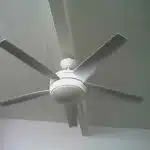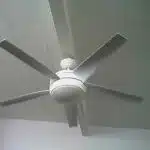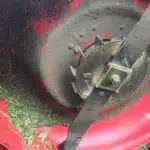The bathroom is one of the most frequently used rooms in any household, making it prone to a buildup of dust and other impurities. One of the crucial components that require regular cleaning in a bathroom is the fan. A dirty fan not only hinders its performance but also poses health risks to the occupants due to its ability to circulate harmful particles. As a cleaning expert, I have seen numerous cases where homeowners overlook this essential part of their bathroom maintenance routine, leading to respiratory issues and energy inefficiency.
Cleaning a dusty bathroom fan may seem like an overwhelming task, but it is an easy process that can be done with simple tools and techniques. In this article, I will provide you with practical steps on how to clean your dusty bathroom fan, ensuring that it functions optimally and promotes good indoor air quality. By following these steps, you will not only prolong the lifespan of your fan but also create a healthy environment for yourself and your loved ones.
Importance Of Regularly Cleaning Your Bathroom Fan
Maintaining a clean and healthy bathroom is essential to keep your home hygienic and germ-free. One of the most overlooked areas in a bathroom is the fan, which is responsible for circulating air and removing moisture. Regularly cleaning your bathroom fan not only ensures that it functions efficiently but also prevents health hazards caused by dust buildup.
Have you ever wondered about the benefits of clean air? Clean air improves overall health and reduces the risk of respiratory problems. A well-maintained bathroom fan helps to eliminate harmful particles such as mold spores, bacteria, and allergens that can cause respiratory issues, particularly in people with allergies or asthma. Thus, ensuring that your bathroom fan is dust-free promotes better indoor air quality.
On the other hand, dust accumulation in your bathroom fan can lead to various health hazards. Dust buildup obstructs airflow, making it difficult for the fan to circulate fresh air effectively. This results in increased levels of humidity in the bathroom, creating an environment that fosters the growth of mold and mildew. Additionally, breathing in dust particles can cause irritation to your nose and throat, leading to coughing and sneezing. Therefore, cleaning your dusty bathroom fan is crucial not only for efficient functioning but also for maintaining good indoor air quality and safeguarding against potential health risks.
To begin cleaning your dusty bathroom fan, you need to gather necessary tools and materials.
Gathering The Necessary Tools And Materials
Regularly cleaning your bathroom fan is crucial in maintaining good indoor air quality and preventing the accumulation of dust and mold. Neglecting to clean it can lead to respiratory problems, allergies, and even fire hazards. Now that you understand the importance of cleaning your bathroom fan, let’s move on to the next section where we will discuss how to gather the necessary tools and materials.
Gathering the necessary tools and materials is essential before starting the cleaning process. You don’t want to be halfway through cleaning your bathroom fan only to realize that you’re missing a crucial tool or material. Here are some items you’ll need:
- Ladder or step stool
- Screwdriver
- Cleaning brush or toothbrush
- Microfiber cloth or feather duster
- Cleaning solution (can be a mixture of water and vinegar)
Before starting any cleaning techniques, always remember to take safety precautions. Turn off the power source of your bathroom fan by switching off the circuit breaker or unplugging it from its power source. This will prevent any accidents from happening while you’re working on it.
Cleaning techniques for a dusty bathroom fan will vary depending on its type and location. However, most bathroom fans can be cleaned by using a screwdriver to remove the cover, brushing away any visible dirt or debris with a cleaning brush or toothbrush, wiping down surfaces with a microfiber cloth or feather duster, and using a cleaning solution to remove any stubborn stains or grime.
By following these simple steps and taking safety precautions, you’ll have a clean bathroom fan in no time! But before we delve into specific techniques on how to clean your bathroom fan, let’s first discuss how important it is to turn off its power source before beginning any work on it.
Turning Off The Power Source
Before cleaning a dusty bathroom fan, it is important to turn off the power source to ensure your safety. This step is crucial because you will be working with electrical connections and removing the cover of the fan. Safety precautions should always come first in every task that involves electricity.
To turn off the power source, locate the circuit breaker panel and switch off the circuit that powers your bathroom. If you are unsure which circuit controls your bathroom, turning off the main power source is recommended. It may seem tedious to turn off the power source, but it is an essential part of cleaning a dusty bathroom fan.
Troubleshooting tips may vary depending on your type of ventilation system. However, if you encounter difficulties in turning off your bathroom’s circuit or main power source, it is best to seek professional help from an electrician. Always prioritize safety when dealing with electrical connections and do not hesitate to ask for assistance when necessary. After turning off the power source, proceed to remove the fan cover as instructed in the next section.
Removing The Fan Cover
Ah, the fan cover. The unsung hero of bathroom cleanliness. It’s amazing how much dust and grime can accumulate on this seemingly insignificant part of your bathroom fan. But fear not, dear reader, for I am here to guide you through the process of safely removing the fan cover and bringing it back to its former glory.
Before we dive into cleaning techniques, let’s talk about why fan maintenance is so important. Not only does a clean fan improve air quality and prevent mold growth in your bathroom, but it also prolongs the life of your fan. By regularly cleaning the blades and cover, you reduce strain on the motor and prevent overheating. Plus, a clean fan just looks nicer and makes for a more pleasant bathroom experience overall.
So, onto removing the cover. First things first, turn off power to the fan by switching off the circuit breaker or unplugging it from its power source if possible. Next, locate the screws holding the cover in place (these are usually located along the sides of the cover). Use a screwdriver to gently remove each screw and set them aside in a safe place where they won’t get lost. Voila! Your fan cover is now ready for cleaning.
Cleaning The Blades With A Vacuum
To clean the blades of your bathroom fan effectively, it’s important to use a vacuum cleaner. However, before proceeding with the cleaning process, you should ensure that your vacuum is well-maintained. Vacuum maintenance is crucial because if your device is not in good condition, it may not be able to suction dust and debris properly.
To prevent dust buildup on the blades of your bathroom fan, you should consider using a vacuum regularly. Dust accumulation can cause the fan to malfunction or even break down entirely over time. As a result, it’s essential to develop a cleaning routine that involves using a vacuum frequently.
When using a vacuum to clean the blades of your bathroom fan, you should be careful not to damage them. Ensure that you’re using an appropriate attachment that won’t scratch or bend the blades. Additionally, move the attachment gently back and forth along each blade to remove all visible dirt and debris thoroughly.
Transition: Now that we’ve covered how to use a vacuum for cleaning dusty bathroom fan blades let’s take a look at another effective method for removing stubborn dirt from them – removing stubborn dirt with a brush.
Removing Stubborn Dirt With A Brush
After vacuuming the blades of your bathroom fan, you may notice that there are still stubborn dirt and dust particles stuck in crevices. This is where using a brush comes in handy to remove those hard-to-reach spots. A good cleaning technique can make all the difference in getting your fan looking clean and new again.
When it comes to brush selection, it’s essential to choose one that is soft-bristled and won’t scratch or damage the fan blades. A paintbrush or makeup brush can work well for this task. Before starting, ensure that the brush is clean and free from any debris that could transfer onto the fan.
To begin cleaning, gently sweep the brush over each blade, starting from the center and working outwards towards the edges. Be sure to get into all of the nooks and crannies of the fan blades. Once complete, use your vacuum with a brush attachment to remove any loose dirt or dust particles left on the blades.
Cleaning a dusty bathroom fan may seem like an overwhelming task, but by using proper techniques such as brush selection and cleaning method, it can be done efficiently. In our next section, we will discuss wiping down the fan cover for a complete clean finish.
Wiping Down The Fan Cover
When it comes to cleaning a dusty bathroom fan, wiping down the cover is an essential step in ensuring that the device operates efficiently. To start, you will need to choose a suitable cleaning product for your fan cover. Avoid using abrasive cleaners or harsh chemicals that could damage the material of the cover. Instead, opt for a mild soap solution or an all-purpose cleaner that is safe for use on plastic or metal surfaces.
Next, you’ll want to grab a step stool or ladder to reach the fan cover. Before climbing onto it, make sure that it is stable and secure on the ground. Once you’re up there, gently remove the fan cover by unscrewing it from its hinges and carefully placing it aside. You can then proceed to wipe down both sides of the cover with your chosen cleaning product and a soft cloth or sponge.
After wiping down the fan cover, be sure to dry it thoroughly before reattaching it back onto the device. This will prevent any water from seeping into the motor or other components of the fan and causing damage over time. With this step complete, you are now ready to move onto cleaning other parts of your bathroom fan such as its motor and other components.
Cleaning The Motor And Other Components
After wiping down the fan cover, it’s time to move on to cleaning the motor and other components of your dusty bathroom fan. Some may be hesitant to clean these parts out of fear of damaging the motor or other important pieces. However, with proper care and attention, cleaning these components is not only safe but essential for keeping your fan functioning properly.
Before diving in, it’s important to gather all necessary materials. This includes a soft brush or cloth, cleaning solvents such as rubbing alcohol or vinegar, and lubrication techniques like oil or silicone spray. These items will aid in removing stubborn dust and debris while also protecting the motor from damage during the cleaning process.
Start by disconnecting power to the fan and removing any easily accessible parts such as the blades and grill cover. Using your chosen cleaning solvent and brush or cloth, gently remove any dirt or grime from these pieces. Once they are clean, apply a small amount of lubricant to keep them running smoothly. For harder-to-reach areas such as inside the motor housing, use compressed air or a vacuum cleaner with an attachment to carefully remove dust without causing harm to any internal parts.
Now that you’ve successfully cleaned all components of your bathroom fan, it’s time to reassemble everything back together. With careful attention paid to every piece you removed earlier, put everything back together in its proper place before turning on the power once again. Your fan should now be running smoother than ever before!
Reassembling The Fan
- An appropriate set of tools must be gathered for the task of cleaning a bathroom fan.
- The fan motor should be checked for any damage or malfunction.
- Careful disassembly of the fan is necessary to access the motor and blades.
- The fan blades should be wiped clean with a damp cloth or towel.
- All components should be reinstalled according to the manufacturer’s instructions.
- After installation, the fan should be tested for proper operation.
Gather Tools
To successfully reassemble your bathroom fan, it is vital to gather all the necessary tools beforehand. Tool organization plays a crucial role in ensuring that you do not waste time looking for items when you need them. Before attempting any cleaning, ensure that you have all the required tools at hand.
One of the essential aspects of tool organization is cleaning safety, which should be a priority when working with electrical appliances. Always unplug the fan before disassembling it and wear gloves and a mask to protect yourself from dust and other contaminants that may cause respiratory problems. Additionally, prepare a clean workspace by covering nearby surfaces with old towels or newspapers to prevent dust from spreading.
Some of the tools required for reassembling your bathroom fan include a screwdriver, pliers, and a soft-bristled brush for dusting vents and blades. Ensure that the screwdriver matches the screws used on your fan to avoid damaging them during disassembly or reassembly. With all these tools organized and ready to use, you will have an easier time cleaning your bathroom fan while minimizing safety risks.
Check Fan Motor
After gathering all the necessary tools for reassembling your bathroom fan, it is crucial to check the fan motor before proceeding. One of the common issues with bathroom fans is fan noise, which may indicate a problem with the fan bearings or other components. To troubleshoot this problem, remove the fan blades and spin the motor shaft to see if it moves smoothly. If you notice any resistance or grinding sounds, it may be time to replace the bearings.
Checking the fan motor is essential because a faulty motor can cause further damage if left unaddressed. For instance, a misaligned or worn-out bearing can cause excessive vibration and noise and eventually lead to motor failure. Therefore, ensure that you replace any faulty components before proceeding with reassembling your bathroom fan.
Once you have checked and resolved any issues with the fan motor, you can proceed with reassembling your bathroom fan using the tools mentioned earlier. Remember to follow safety guidelines when working with electrical appliances, such as wearing gloves and unplugging the device before disassembly. With proper tool organization and attention to detail during reassembly, your bathroom fan will function efficiently for years to come.
Install Fan Blades
After ensuring that the fan motor is in good condition, the next step in reassembling your bathroom fan is installing the fan blades. Installing fan blades is an essential part of maintaining your bathroom fan’s longevity and efficiency. Fan blade maintenance can help prevent issues such as noise, vibration, and poor airflow. Therefore, it is crucial to ensure you install the blades correctly for optimal performance.
To install the fan blades, attach each blade to its respective bracket using screws or clips. Ensure that each blade is secure and levelled with the others to avoid any imbalances that may cause noise or vibration. Once you have attached all the blades, switch on the power supply to test if they are functioning correctly. If there are any issues, double-check your installation to ensure that all components are secure.
With proper installation of fan blades, your bathroom fan will operate quietly and efficiently for years to come. Regular maintenance of your fan blades can also prolong their lifespan, ensuring optimal performance. Therefore, it is crucial to clean your bathroom fan regularly using a soft cloth or brush and remove any debris that may interfere with its performance. By following these simple steps in reassembling your bathroom fan, you can keep your home’s air fresh and clean while enjoying peace of mind knowing that your bathroom fan is operating efficiently.
Turning The Power Back On
Before turning the power back on, it is important to take safety precautions. Make sure that all equipment and tools are safely stored away from electrical outlets and water sources. Additionally, ensure that the bathroom is dry before proceeding with turning the power back on. Failure to adhere to these safety precautions could lead to electrocution or other accidents.
If you experience any issues when turning the power back on, there are troubleshooting techniques that can be employed. For instance, if the fan does not turn on, check to see if it is properly connected to its power source. If it still does not turn on after being connected properly, consider checking the circuit breaker for any tripped switches. Also, ensure that the fan’s wiring is not damaged or frayed.
After taking safety precautions and troubleshooting potential issues, you can proceed with testing the fan’s performance. Turn on the fan and listen for any unusual sounds or vibrations. Also, check to see if it is effectively removing moisture and odors from your bathroom space. If everything seems normal, then congratulations! You have successfully cleaned your dusty bathroom fan and restored its functionality.
Testing The Fan’s Performance
- To test the fan’s speed, a fan speed measurement device should be used to measure the speed of the fan blades while the fan is running.
- To test the fan’s noise levels, a sound level meter should be used to measure the decibel level of the fan when it is running.
- The fan should be tested at its highest speed setting to ensure accurate results.
- The results of the tests should be compared to manufacturer’s specifications to ensure the fan is operating correctly.
Testing The Fan’s Speed
Are you wondering if your bathroom fan is still performing well? One way to test its performance is by checking its airflow. This can help identify whether the fan needs maintenance or replacement. Fan maintenance is essential in keeping the bathroom clean and free from dust and moisture.
To test the airflow of a bathroom fan, turn it on and hold a tissue or piece of paper near the vent. The paper should stick to the vent with enough force to indicate that there’s proper air movement. If the paper doesn’t stick, it could mean that the fan isn’t working correctly, or there might be something blocking the airflow. In this case, cleaning or replacing the fan might be necessary.
Another way to test your fan’s speed is by using a handheld anemometer. An anemometer measures wind speed and direction, which can help determine whether your fan is still functioning at optimum levels. Place the anemometer directly in front of the fan and check its reading. It should show an average airflow rate between 50-80 cubic feet per minute (CFM).If it reads lower than 50 CFM, you may need to clean or replace your bathroom fan for better performance.
Testing your bathroom fan’s performance ensures that it’s operating correctly and preventing moisture buildup in your home. Remember that regular maintenance is crucial for proper ventilation in your bathroom. Don’t wait until mold and mildew start forming before you act on issues with your bathroom fans!
Testing The Fan’s Noise Levels
When it comes to testing the performance of your bathroom fan, checking its airflow is not enough. Another crucial factor to consider is the noise level produced by the fan. A noisy fan can be a sign of a worn-out or damaged motor or other parts that need maintenance. Testing noise levels can help identify these issues and ensure that your bathroom fan continues to operate effectively.
To test the noise level of your bathroom fan, turn it on and listen closely. A properly working fan should produce minimal noise, which shouldn’t be too distracting or irritating. If you notice that your bathroom fan produces a loud humming or rattling sound, it might be time for maintenance or replacement.
The frequency of maintaining your bathroom fan depends on several factors such as usage and environment. However, experts recommend cleaning the fan every six months and checking its performance indicators regularly, including airflow and noise levels. Regular maintenance ensures that your bathroom fan operates efficiently, reducing energy costs, and preventing moisture buildup in your home.
Tips For Preventing Future Buildup
As the saying goes, prevention is better than cure. This also holds true for bathroom fan maintenance. One of the best ways to prevent future buildup in your bathroom fan is by reducing moisture in the room. Moisture can cause mold and mildew growth, which can accumulate on the fan blades and inside the motor housing. To prevent moisture buildup, make sure to turn on the exhaust fan during and after showering, keep windows open for ventilation, and wipe down any wet surfaces.
Another important aspect of preventing future buildup is regular airflow maintenance. A clean and well-maintained bathroom fan will work more efficiently and effectively in removing moisture from the air. It’s recommended to clean your bathroom fan at least twice a year to remove any accumulated dust or debris that may hinder its airflow. You can do this by using a vacuum with a soft brush attachment or wiping down the blades with a damp cloth.
To further maintain optimal airflow in your bathroom, make sure there are no obstructions around or inside the fan housing. This includes checking for any dirt or debris that may have accumulated on the outside vent cover or inside ductwork. By taking these preventive measures, you’ll not only ensure a clean bathroom environment but also extend the life of your bathroom fan.
Transition: While regular cleaning and maintenance are important for keeping your bathroom fan functioning properly, there are alternative cleaning methods that can be used as well.
Alternative Cleaning Methods
Aside from using a damp cloth or vacuum cleaner, there are alternative cleaning methods that can be utilized for a dusty bathroom fan. One of which is dry cleaning. This method involves the use of a microfiber cloth or a soft-bristled brush to remove dust and dirt from the fan blades. It is important to note that dry cleaning should be done gently, ensuring not to damage any part of the fan.
Another option for those who prefer natural solutions is by using vinegar and baking soda. These two ingredients combined can create a powerful cleaning solution that can effectively remove dust and grime from the bathroom fan. Simply mix equal parts white vinegar and water in a spray bottle, then apply it onto the fan blades. Afterward, sprinkle a generous amount of baking soda onto the blades and let it sit for a few minutes before wiping it off with a clean cloth.
It is crucial to keep in mind that proper maintenance of bathroom fans is essential to ensure their longevity and efficiency. Regularly cleaning them not only prevents dust buildup but also helps maintain good indoor air quality. With this in mind, it is imperative to never neglect your bathroom fans as they play an important role in maintaining proper ventilation in your home.
Transitioning into our next topic, let’s dive deeper into the importance of proper ventilation in the bathroom and how it affects our health and well-being.
Importance Of Proper Ventilation In The Bathroom
Proper ventilation is essential in the bathroom, and an exhaust fan is one of the most effective ways to achieve this. It helps eliminate excess moisture, odors, and pollutants that can cause damage to walls and ceilings while creating an unpleasant environment for users. The benefits of using an exhaust fan in the bathroom are numerous, including reduced humidity levels, improved air quality, and lower risk of mold growth.
Common problems caused by poor bathroom ventilation include peeling paint, warped woodwork, and mildew growth. These issues can lead to costly repairs and pose potential health risks to individuals who use the bathroom regularly. In extreme cases, poor ventilation can even cause structural damage to a home’s foundation or framing.
To avoid these problems from occurring in your bathroom, it is crucial to ensure proper ventilation by using an exhaust fan. Regular maintenance of your fan is also important to avoid dust accumulation that can reduce its efficiency. Keeping your bathroom fan clean will not only improve its functionality but also keep your indoor air quality at optimal levels. In turn, you’ll enjoy a healthier living space free from harmful pollutants that can compromise your well-being.
Conclusion: Keep Your Bathroom Fan Clean For Optimal Functionality And Air Quality
Keeping your bathroom fan clean is essential for optimal functionality and air quality. It not only helps to prevent dust accumulation, but it also reduces the risk of mold growth and improves ventilation. By following some simple maintenance tips, you can ensure that your bathroom fan stays clean and healthy.
One important tip is to regularly remove the fan cover and wash it with soap and water. This should be done every three months or so, depending on how often you use your bathroom. Additionally, using a vacuum cleaner or a soft brush to clean the blades of the fan will help to remove any accumulated dust or debris.
Another way to keep your bathroom fan clean is by using a damp cloth or sponge to wipe down the exterior of the fan unit. This will help to remove any dirt or grime that may have accumulated over time. Remember to turn off the power before cleaning, and avoid using harsh chemicals that could damage the fan.
Overall, keeping your bathroom fan clean has numerous health benefits, including improved air quality and reduced risk of respiratory problems. By following these simple maintenance tips, you can ensure that your bathroom fan functions properly and efficiently for years to come.
Conclusion
Regularly cleaning your bathroom fan is crucial for optimal functionality and air quality. Dust and debris can accumulate on the blades, making it less efficient and potentially causing health hazards such as mold growth. To clean your fan, gather a vacuum, a soft-bristled brush, and a damp cloth. Turn off the power source and remove the cover carefully. Clean the blades with the vacuum and brush, wiping them down with the damp cloth.
To prevent future buildup, consider running the fan during showers or baths to help reduce moisture in the air. Additionally, placing an air purifier in your bathroom can help to remove airborne particles that may contribute to dust accumulation.
Alternative cleaning methods include using compressed air or a steam cleaner to remove tough grime. However, be sure to read manufacturer guidelines before attempting any alternative methods.
Proper ventilation in your bathroom is essential for maintaining good air quality. Neglecting to clean your fan regularly can lead to poor ventilation and potential health risks. Invest time in cleaning your bathroom fan for optimal functionality and air quality in your home.
Image Credits
- “white ceramic bathtub” by Jared Rice (featured)





























